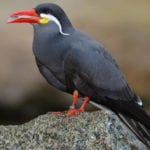 Our World
Our World  Our World
Our World  Pop Culture
Pop Culture 10 Incredible Female Comic Book Artists
 Crime
Crime 10 Terrifying Serial Killers from Centuries Ago
 Technology
Technology 10 Hilariously Over-Engineered Solutions to Simple Problems
 Miscellaneous
Miscellaneous 10 Ironic News Stories Straight out of an Alanis Morissette Song
 Politics
Politics 10 Lesser-Known Far-Right Groups of the 21st Century
 History
History Ten Revealing Facts about Daily Domestic Life in the Old West
 Weird Stuff
Weird Stuff 10 Everyday Products Surprisingly Made by Inmates
 Movies and TV
Movies and TV 10 Actors Dragged out of Retirement for One Key Role
 Creepy
Creepy 10 Lesser-Known Shapeshifter Legends from Around the World
 Our World
Our World 10 Science Facts That Will Change How You Look at the World
 Pop Culture
Pop Culture 10 Incredible Female Comic Book Artists
 Crime
Crime 10 Terrifying Serial Killers from Centuries Ago
Who's Behind Listverse?

Jamie Frater
Head Editor
Jamie founded Listverse due to an insatiable desire to share fascinating, obscure, and bizarre facts. He has been a guest speaker on numerous national radio and television stations and is a five time published author.
More About Us Technology
Technology 10 Hilariously Over-Engineered Solutions to Simple Problems
 Miscellaneous
Miscellaneous 10 Ironic News Stories Straight out of an Alanis Morissette Song
 Politics
Politics 10 Lesser-Known Far-Right Groups of the 21st Century
 History
History Ten Revealing Facts about Daily Domestic Life in the Old West
 Weird Stuff
Weird Stuff 10 Everyday Products Surprisingly Made by Inmates
 Movies and TV
Movies and TV 10 Actors Dragged out of Retirement for One Key Role
 Creepy
Creepy 10 Lesser-Known Shapeshifter Legends from Around the World
10 Sets Of Species Fighting An Evolutionary Arms Race
Evolution has helped the most adaptive animals survive. Often, two or more species find themselves evolving and competing in the same ecosystem. This can take the form of a predator–prey relationship as well as competition for resources and many other types of coevolution. Organisms sometimes evolve side by side, each one adapting to overcome the other.
10Caterpillars, Corn, & Wasps
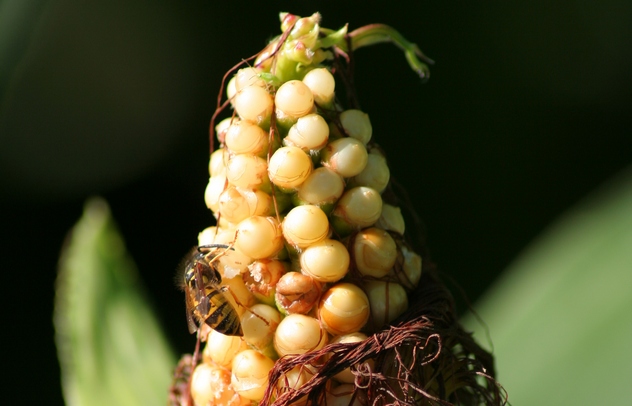
When we think of an evolutionary arms race, we probably aren’t picturing the relationship between corn, caterpillars, and wasps, but that’s exactly what’s going on. When a caterpillar decides it wants to munch on some corn, the plant is able to release a gaseous chemical called a “terpenoid” from both its damaged and undamaged leaves. Once in the air, the terpenoid attracts a species of parasitic wasp (Cotesia marginiventris) that sees the caterpillar and decides it would be a good thing to lay its egg in. This results in the untimely death of the corn-eating would-be butterfly and the successful breeding of the wasp. Of course, the corn continues its existence and will keep putting out terpenoids whenever it feels threatened by something its bodyguard wasps might like to lay eggs in.
Current winner: Both the corn and the wasps are winning against the caterpillars of the world in this battle for survival.
9Fruit Flies & Mustard Plants
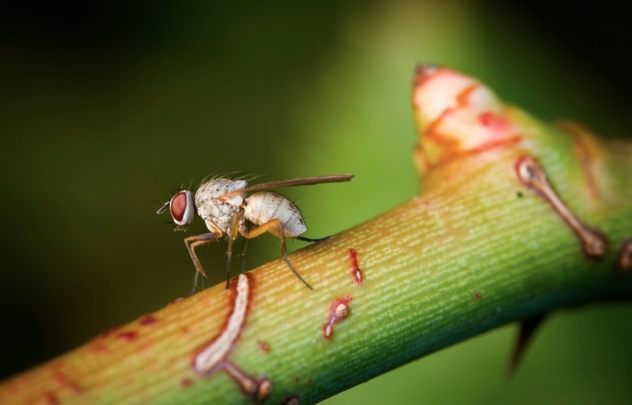
Insects and plants have been battling a war since the first bug landed on the first leaf long ago. Plants don’t tend to move around too much, so insects have enjoyed them as both sources of food and as homes. Some plants have evolved to defend against insects by growing thicker skin in the form of bark or by producing an enzyme that is either distasteful or harmful to whatever might ingest it.
In a very small ecosystem consisting of only two species, a fruit fly and a mustard plant are battling to the death. While most species of fruit flies enjoy rotting fruit, one species—Scaptomyza flava—subsists almost entirely on a species of mustard plant (Arabidopsis). The flies spend their entire life cycle on the plant. First as larvae, they burrow tunnels through the plant’s leaves while eating the juices they produce. This has left the plant little option to defend itself, but it has found a way. Arabidopsis produces a protein that inhibits digestion in the larval flies. When they eat it, they tend to die out or at least move a little slower. This has allowed the plants to survive even while they are being eaten by the parasitic flies.
Current winner: Arabidopsis has found a way to survive while being constantly eaten by flies. Once the flies evolve to be able to ingest the proteins, the plants may be able to ramp up their production into something more toxic . . . and the race will go on.
8Greater Honeyguides & Greater Honeyguides
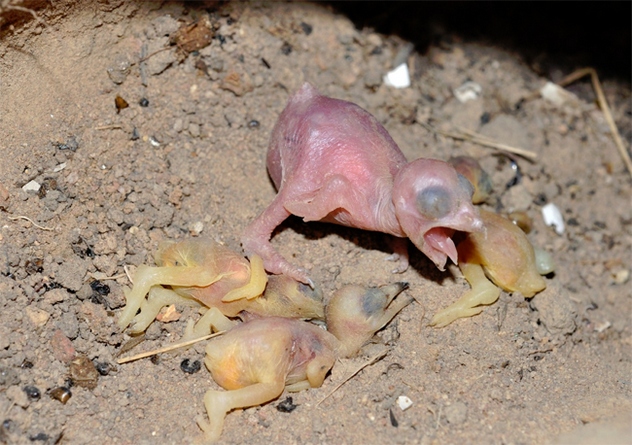
Yes, you read that correctly. The greater honeyguide is involved in an evolutionary arms race with members of its own species. Greater honeyguides exhibit a trait called “brood parasitism.” Basically, they lay their eggs in other birds’ nests, specifically in the underground nests of little bee-eaters (Merops pusillus). In order to get away with this, the honeyguides have evolved their egg-laying abilities into a pretty neat trick: They can make their eggs look just like the eggs of their target species. While you might think this is meant to fool the little bee-eaters, it isn’t. As it turns out, little bee-eaters don’t really care what the eggs in their nest look like—but other honeyguides do.
When a honeyguide lays its eggs in a little bee-eater’s nest, it punctures the host eggs to kill the young. This doesn’t kill all of them, since they can’t completely destroy the nest for fear of the little bee-eaters abandoning it. The chicks that do hatch are killed by the honeyguide chicks via their hooked beaks. When a honeyguide comes upon a nest and identifies some of the eggs as belonging to another honeyguide, it destroys those eggs with reckless abandon, which suggests that the birds are competing with each other for nest space. This means that the honeyguide’s ability to make its eggs look like those of the little bee-eaters is not meant to fool the foster parents but to hopefully fool others of their species so that their own chicks might survive a vicious attack by a would-be momma bird.
Current winner: Nobody, really. Since the greater honeyguide (Indicator indicator) is competing with itself, it is only hurting itself in the long run. The real losers are the little bee-eaters, since their chicks suffer the most.
7Cheetahs & Gazelles
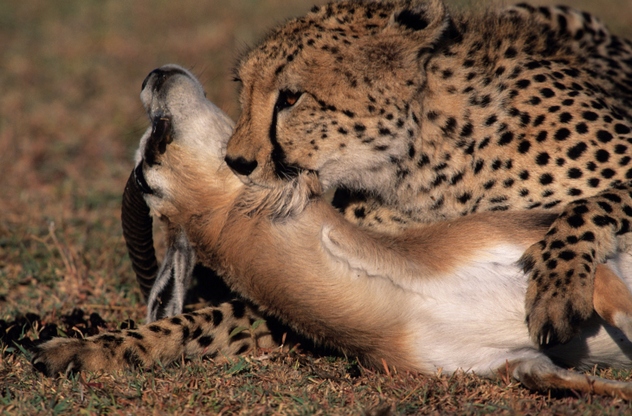
We all know that the cheetah (Acinonyx jubatus) is the fastest animal out there, able to reach speeds of up to 120 kilometers per hour (75 mph). If it were a superhero, it would have a lightning bolt on its chest. That said, most folks are aware that cheetahs primarily prey on the lovely gazelle (Gazella).
These two species are primary examples of an evolutionary arms race wherein each successive generation adapts to survive better than the previous one. When a cheetah fails to catch its prey, it might not survive, which leaves the faster cheetahs around to feed on the slower gazelle. The same is true for the gazelle as a prey animal: The slower gazelles die out while the faster ones survive. Over countless generations, the cheetah has evolved to become the fastest predator on Earth, while the gazelle has adapted to become an extremely fast and elusive meal.
Current winner: The cheetah is the current winner in this evolutionary arms race due to its ability to catch its prey. Cheetahs are usually successful in catching just about anything that chooses to run from them, so until the gazelle develops a powerful defense mechanism, the cheetah has this one.
6Ant-Mimicking Spiders & Ants
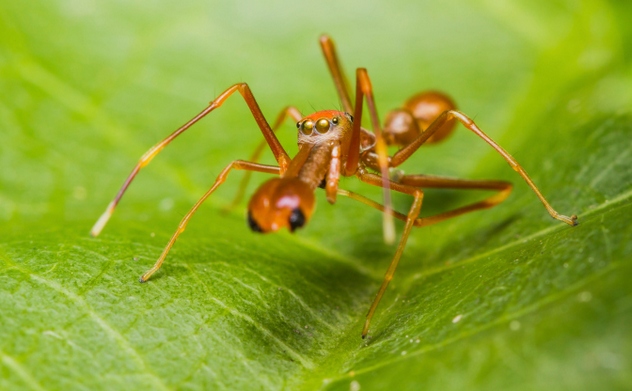
Ant mimicry is a prevalent adaptation found among many species of jumping spiders all over the planet. Usually, the spider will live among an ant population while pretending to be a part of it through some form of social or chemical (smell) means of masking itself. The spiders don’t usually prey on the ant population, because ants tend to swarm aggressively to defend against predators, even those they believe to be other ants. In most cases, the spiders use the ant colony for defense and simply live among them. Yet one species of jumping spider in New Guinea, Australia, and Micronesia has decided that ants taste pretty good and doesn’t care about the risks.
Cosmophasis bitaeniata likes to hang around the green tree ant (Oecophylla smaragdina) and prey on its larvae. It does this by looking similar to the ants (ants don’t see very well) and by using an adaptation called “exploitative chemical mimicry,” wherein the spider is able to mask its scent and smell like the rest of the ants via a chemical compound it emits. When the spider gets a bit hungry, it avoids the major workers during the day but finds the minor workers and steals larvae directly from their mandibles. The ants assume they are passing off their brood to another ant worker, but the spider just enjoys a light snack before going back for more.
Current winner: The jumping spider currently holds all the cards in this game, until the ants figure out that the continuing disappearance of their young might have something to do with the continued fattening of a weird-looking ant in their midst.
5Sierra Garter Snake & Sierra Newt
When predator and prey evolve side by side, there is often a single characteristic of one of the two species that helps to drive adaptation. In the case of the Sierra garter snake (Thamnophis sirtalis) and the Sierra newt (Taricha granulosa), that characteristic is the neurotoxin tetrodotoxin (TTX). TTX is a neurotoxin that is found in amphibians and various species of fish such as the pufferfish. If a person were to ingest the toxin from one of the newts, they could die within 17 minutes of ingestion. Other symptoms include respiratory failure, hypotension, and coma. (Note: Don’t go around picking up newts and eating them . . . just to be on the safe side.) TTX is highly toxic and is found in all newts of the Taricha genus, making it lethal prey to almost anything that might come along and fancy a taste.
The one species that seems to be able to tackle TTX is the Sierra garter snake. In some populations of the Sierra garter snake—namely those that cohabitate with the Sierra newt—the snakes have evolved a resistance to TTX, allowing them to ingest the newt. This has helped the local population of snakes to successfully prey on an otherwise non-preyed-upon species.
Current winner: The Sierra garter snake is winning, since it is able to successfully prey on the newt without any ingestion complications. Perhaps in the future, the newt will evolve a deadlier form of TTX, but at the moment, it comes in second in this evolutionary arms race.
4Sea Urchins & Sea Lilies
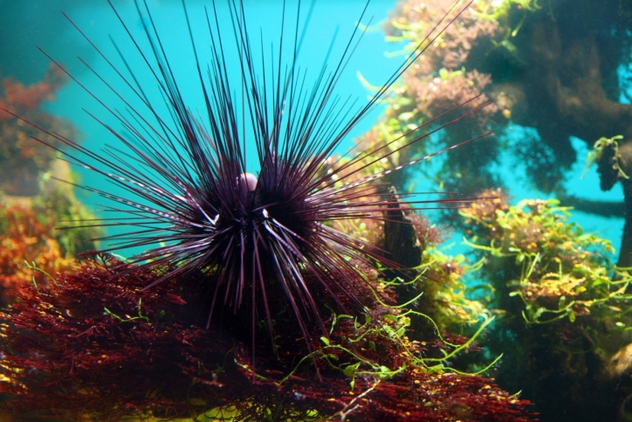
We don’t often think of sea urchins as predatory beasts that help to shape the very nature of their prey, but that is exactly what they are. Sea urchins have helped to shape the evolution of the sea lily for the past 200 million years. Sea lilies, or Mesozoic crinoids, were forced by their predators to renounce their stationary ways and become mobile. This is called “predator-induced macroevolution,” and it happens when a species is threatened to the point where a mutation is required for continued survival.
The sea lily saw the sea urchin moving its way and decided it needed the genes necessary to move along . . . and that’s exactly what happened. This has been visible in the fossil record through the Mesozoic period. Fossils of sea lilies have indicated predation by sea urchins for hundreds of millions of years, showing a long-term predator–prey relationship. By about the time the dinosaurs went extinct, Mesozoic crinoid species began diversifying into mobile species while the stationary ones began to die off.
Current winner: Sea lilies are currently winning this evolutionary arms race because the number of mobile species has surpassed the sea urchins. While they do remain the prey of the sea urchins, they are not often found on the menu.
3Bats & Moths
A tiger moth (Carales arizonensis) in Arizona has found itself at arms with the local bat population by evolving a pretty neat trick. Bats mostly hunt insects at night and do so by using echolocation. They are able to determine the distance and speed of any prey they are chasing, which has helped them to become excellent nocturnal predators. Most bats eat approximately 600 insects per hour, but the tiger moth is rarely found on the menu.
The tiger moth has developed two separate methods of removing itself from a bat’s ideal meal. First, tiger moths emit a toxin that is distasteful to bats. Second, they use an organ called a “tymbal” to create a series of high-pitched clicks that work to identify the tiger moths as something the bats don’t like to eat. For this to work, each bat would have to have eaten at least one moth in the past, discovered they don’t taste very good, and learned not to eat them. Once that happens, any bat that has dined on the nasty moths in the past will “hear” the clicks, identify the moth, and move on to tastier prey.
Current winner: Tiger moth holds the trophy at the moment, though if bats evolve beyond the distaste for the toxin, the moths will have to step up the arms race somehow.
2The Malaysian Carpenter Ant & Weaver Ants
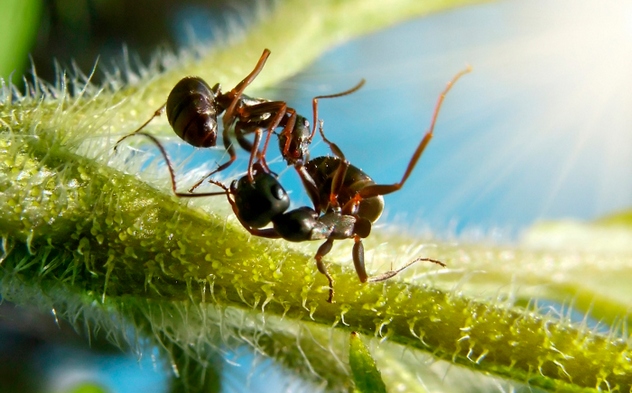
The Malaysian carpenter ant (Camponotus saundersi), also known as the “exploding ant,” has evolved a very strange trait. Once attacked, an ant will altruistically commit suicide and blow itself up. This causes a sticky substance that was formerly on the inside of the ant to stick to the animal that attacked it. Essentially, the predator is unable to further threaten the colony and must find a way to remove the sticky substance before attacking more ants. The ant is able to do this due to a unique poison-filled mandibular gland that runs the entire length of its body. When threatened, it can contract its abdominal muscles and cause the glands to burst. The glue that comes out is both corrosive and acts as a chemical irritant.
The main predator of these suicidal ants is another ant species: weaver ants (Oecophylla smaragdina), also known as “green ants” (even though they are red). Weaver ants are extremely aggressive and territorial, so they have become a natural predator of the exploding ant. These two ant species evolved alongside one another while fighting for resources, but carpenter ant colonies are almost always safe from weaver ants because of their altruistic suicidal nature. Even though a single ant has to die in order to halt predation, the entire colony benefits and continues to thrive, taking resources and potential habitats away from their main source of competition.
Current winner: The Malaysian carpenter ant is the current winner, since it is able to protect the majority of the colony through a single act of altruistic suicide.
1The Golden Poison Frog & Water Snake
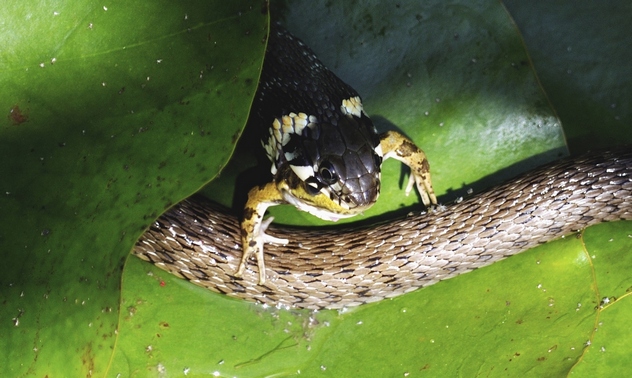
The golden poison frog (Phyllobates terribilis) is the most poisonous animal in the world. That’s right: A pretty little froggy can secrete enough poison from its skin to kill 22,000 mice. Because the frog secretes the toxin from its skin, it is used solely as a defense mechanism. Normally, any animal foolhardy enough to attempt to eat one of these frogs would die almost immediately (this includes humans), but there is one species that has evolved alongside the golden poison frog to give it a run for its money.
A species of water snake in South America—Liophis epinephelus—is the only known animal that has built up resistance to the frog’s toxin. While not immune to the toxin, the water snake is capable of ingesting and surviving the frog’s deadly secretions. This makes the snake unique in the frog’s ecosystem. Because the frogs are not preyed on by other species, the snake has found itself on the winning side of the two species’ evolutionary arms race. While the frog would kill anything else that would like to eat it, the snake will swallow the frog whole and slither on to prey on it another day.
Current winner: The water snake takes the lead with its ability to eat and run.
I am an amateur graphic artist, illustrator, and game designer with a few independently-published games through my game company, TalkingBull Games. I enjoy researching and writing about history, science, theology, and many other subjects. Find me on Fiverr, Facebook, Twitter, Kickstarter, and DeviantArt.







